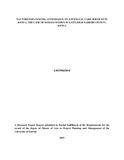| dc.description.abstract | Approximately 1000 women die each day worldwide from pregnancy related causes,
99% of them in developing countries and more than 50% in sub-Saharan Africa with most deaths
concentrated around the time of delivery. Most of these delivery time deaths would have reduced
if antenatal services were readily available and fully utilized by all expectant mothers. The study
set out to investigate the influencing factors to the attendance of antenatal care services among
the Somali women in Nairobi, Kenya. The objectives of the study were ;To establish the
influence of the presence of Traditional Birth Attendants (TBAs) in antenatal services seeking
behavior among Somali women in Eastleigh, Nairobi, investigate the extent to which level of
awareness influences attendance to antenatal care by the Somali women in Eastleigh, Nairobi
County, investigate how cultural beliefs towards modern reproductive services affect antenatal
seeking behavior among the Somali women in Eastleigh, Nairobi and find out how economic
status contribute to the number of Somali women who seek antenatal care. The target population
was all Somali women living in Nairobi. This study grew out of an observation made by the
researcher during a Parliamentary Health Committee tour to the Pumwani Maternity and most
recent Journals in the facility, which indicated most of the babies in the incubators, and still
births, were of Somali origin. Sample size was determined by use of online formula for sample
size determination at http://www.raosoft.com/samplesize.html and adopted snowball sampling
in the study. Questionnaires were pre-tested at the School of Communication at Daystar
University, Nairobi. Data collection was carried out by the researcher over a period of four
weeks by use of self administered questionnaires from respondents who could read and write and
also with the assistance of a research assistant for the illiterate respondents. All questionnaires
were edited and responses coded before data was entered into the computer by the use of the
Statistical Program for Social Scientists (SPSS), version 11.5. Cross tabulation was the main
method used for data analysis. After analysis, data was summarized and presented in form of
frequency tables, percentages and proportions. Majority respondents were within the active ages
of reproduction with a majority 72% practicing Islam while 50.8% had no formal education.
There was great reliance of TBAs with a strong correlation between attendance of antenatal care
and the final delivery aid where 81.4% of the respondents reported to have relied on the same
service providers during their delivery period. The study established great need of awareness
programmes geared towards enlightening the Somali women with 63.6% of the respondents
unaware since most of them were illiterate. The study recommended that women be encouraged
to undertake entrepreneurial activities since there was high relationship of economic status and
attendance to antenatal clinics. | en_US |

